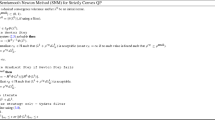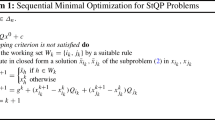Abstract
A structural optimization problem is usually solved iteratively as a sequence of approximate design problems. Traditionally, a variety of approximation concepts are used, but lately second-order approximation strategies have received most interest since high quality approximations can be obtained in this way. Furthermore, difficulties in choosing tuning parameters such as step-size restrictions may be avoided in these approaches. Methods that utilize second-order approximations can be divided into two groups; in the first, a Quadratic Programming (QP) subproblem including all available second-order information is stated, after which it is solved with a standard QP method, whereas the second approach uses only an approximate QP subproblem whose underlying structure can be efficiently exploited. In the latter case, only the diagonal terms of the second-order information are used, which makes it possible to adopt dual methods that require separability. An advantage of the first group of methods is that all available second-order information is used when stating the approximate problem, but a disadvantage is that a rather difficult QP subproblem must be solved in each iteration. The second group of methods benefits from the possibility of using efficient dual methods, but lacks in not using all available information. In this paper, we propose an efficient approach to solve the QP problems, based on the creation of a sequence of fully separable subproblems, each of which is efficiently solvable by dual methods. This procedure makes it possible to combine the advantages of each of the two former approaches. The numerical results show that the proposed solution procedure is a valid approach to solve the QP subproblems arising in second-order approximation schemes.
Similar content being viewed by others
References
Adelman, H.M.; Haftka, R.T. 1986: Sensitivity analysis of discrete structural systems.AIAA J. 24, 823–832
Bazaraa, M. S.; Shetty, C. M. 1979:Nonlinear programming. New York: John Wiley & Sons
Belegundu, A.D.; Arora, J.S. 1984: A recursive quadratic programming method with active set strategy for optimal design.Int. J. Num. Meth. Eng. 20, 803–816
Choi, K.K.; Haug, E.J.; Hou, J.W.; Sohoni, V.N. 1983: Pshenichnyj's linearization method for mechanical system optimization.J. Mech. Trans. Auto. Des. 105, 97–103
Fleury, C. 1979: Structural weight optimization by dual methods of convex programming.Int. J. Num. Meth. Eng. 14, 1761–1783
Fleury, C. 1989a: First and second order approximation strategies in structural optimization.Struct. Optim. 1, 3–10
Fleury, C. 1989b: CONLIN: an efficient dual optimizer based on convex approximation concepts.Struct. Optim. 1, 81–89
Fleury, C.; Braibant, V. 1985: Structural optimization: a new dual method using mixed variables.Int. J. Num. Meth. Eng. 23, 409–428
Fleury, C.; Schmit, L.A. 1980: Primal and dual methods in structural optimization.J. Struct. Div. 106, 1117–1133
Fleury, C.; Smaoui, H. 1988: Convex approximation strategies in structural optimization. In: Eschenauer, H.A.; Thierauf, G. (eds.)Discretization methods and structural optimization - procedures and applications, pp. 118–126. Berlin, Heidelberg, New York: Springer
Frank, M.; Wolfe, P. 1956: An algorithm for quadratic programming.Naval Research Logistics Quarterly 3, 95–110
Griffith, R.E.; Stewart, R.A. 1961: A non-linear programming technique for the optimization of continuous processing systems.Management Science 7, 379–392
Han, S.P. 1976: Superlinearly convergent variable metric algorithms for general nonlinear programming problems.Mathematical Programming 11, 263–282
Han, S.P. 1977: A globally convergent method for nonlinear programming.J. Optimiz. Theory Appl. 22, 297–309
Kirsch, U. 1981:Optimum structural design. New York: McGraw-Hill
Jonsson, Ö.; Larsson, T. 1990: A note on step-size restrictions in approximation procedures for structural optimization.Comp. & Struct. 37, 259–263
Larsson, T.; Migdalas, A. 1990: An algorithm for nonlinear programs over Cartesian product sets.Optimization 21, 535–542
Lim, O.K.; Arora, J.S. 1986: An active set RQP algorithm for engineering design optimization.Comp. Meth. Appl. Mech. Eng. 57, 51–65
Pshenichnyj, B.N. 1970: Algorithms for the general problem of mathematical programming.Kibernetica 5, 120–125
Pshenichnyj, B.N. 1987: The linearization method.Optimization 18, 179–196
Renwei, X.; Peng, L. 1987: Structural optimization based on second-order approximations of functions and dual theory.Comp. Meth. Appl. Mech. Eng. 65, 101–114
Ringertz, U.T. 1988:A mathematical programming approach to structural optimization. Doctoral Thesis, Report No. 88-24, Royal Institute of Technology, Stockholm
Schittkowski, K. 1983: On the convergence of a sequential quadratic programming method.Optimization 14, 197–216
Schmit, L.A.; Fleury, C. 1980: Structural synthesis by combining approximation concepts and dual methods.AIAA J. 18, 1252–1260
Starnes, J.H.; Haftka, R.T. 1979: Preliminary design of composite wings for bucklings, strength and displacement constraints.J. Aircraft 16, 564–570
Svanberg, K. 1982: An algorithm for optimum structural design using duality.Mathematical Programming Study 20, 161–177
Svanberg, K. 1987: The method of moving asymptotes - a new method for structural optimization.Int. J. Num. Meth. Eng. 24, 359–373
van de Panne, C. 1975:Methods for linear and quadratic programming. Amsterdam: North-Holland
Wilson, R.B. 1963:A simplicial method for concave programming. Ph.D. Dissertation, Harvard University, Cambridge, Mass.
Woo, T.H. 1986: Space frame optimization subject to frequency constraints.Proc. AIAA/ASME/ASCE/AHS 27th Structures, Structural Dynamics, and Materials Conf., pp. 103–115
Author information
Authors and Affiliations
Rights and permissions
About this article
Cite this article
Larsson, T., Rönnqvist, M. A method for structural optimization which combines secondorder approximations and dual techniques. Structural Optimization 5, 225–232 (1993). https://doi.org/10.1007/BF01743583
Received:
Revised:
Issue Date:
DOI: https://doi.org/10.1007/BF01743583




